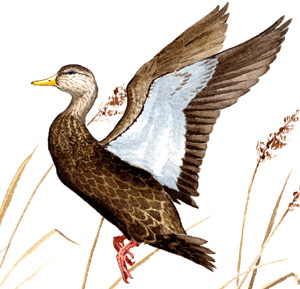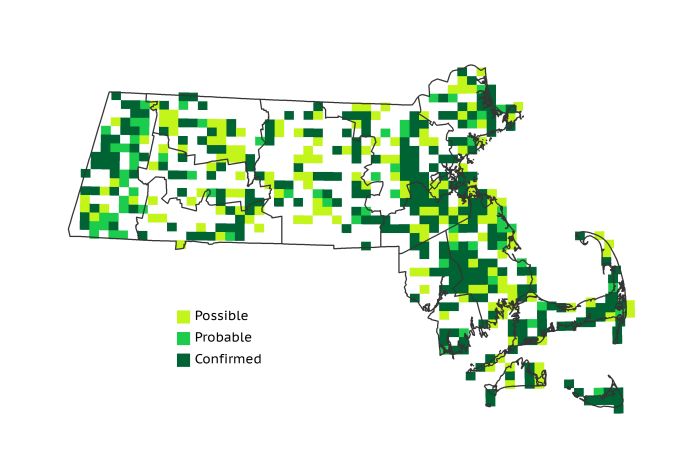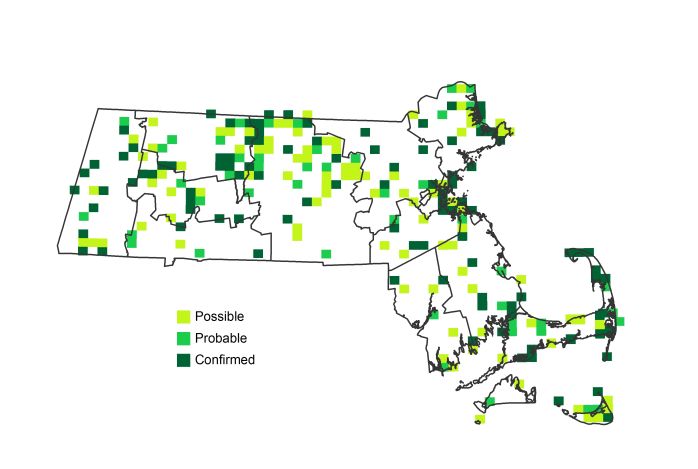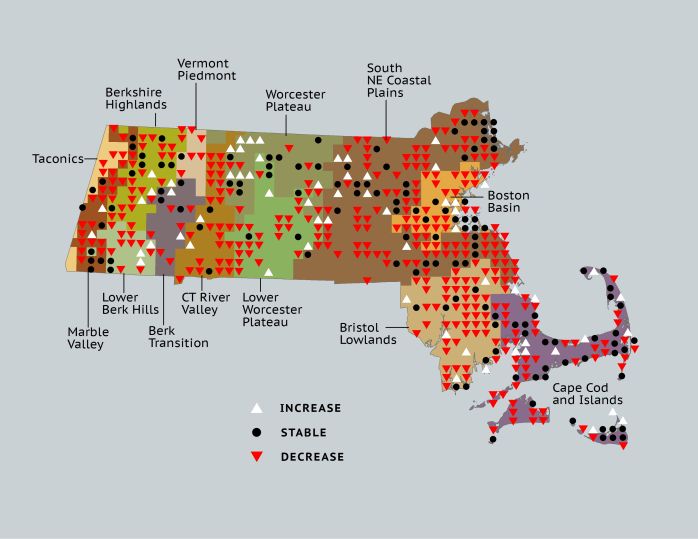Find a Bird
American Black Duck
Anas rubripes

Somewhat local and strongly declining
Conservation action urgent
State Wildlife Action Plan listed
“When alarmed [the ducklings] would dive with great celerity several times in succession, but soon became fatigued, made for the shore, ran a few feet from the water, and squatted among the grass, where they were easily caught either by some of our party, or by the Gulls, which are constantly on the look-out for such dainty food.” – John James Audubon, Birds of America
The depredations of human hunters and hungry gulls are but drops in the bucket compared with the challenges faced by American Black Ducks in Massachusetts today. Formerly one of the most widespread and familiar duck species in the Commonwealth, the American Black Duck historically bred from the deltas of the Connecticut River to the tidal marshes of Cape Cod and at many locations in between. The increase of Mallards and the loss of wetland habitat in Massachusetts have combined to make modern life difficult for this once-common native waterfowl species, although, with the scale of the loss in this species it is likely there are more drivers of decline acting on this species.
Historic Status
At one time, hunters and birders in Massachusetts believed they were seeing two separate subspecies of black ducks, Anas rubripes rubripes, the Red-legged (or Winter) Black Duck, and Anas rubripes tristis, the (Summer) Black Duck (Forbush 1925, Phillips 1920). Once the differences between these alleged subspecies were determined to in actuality be sex, age, and possibly even seasonally related rather than pertaining to genetic differences, they were correctly lumped together as representing one and the same species. Regardless of these taxonomic issues, by the 1940s life was becoming increasingly inhospitable for American Black Ducks in Massachusetts. They had successfully survived market gunning for two centuries before other human incursions on their lives set them on a downward trend. Possibly most important was the fact that half of the shallow freshwater marshes existing in Massachusetts in 1951 were lost to development by 1971. Pesticides, urbanization, and further habitat destruction would follow.
Atlas 1 Distribution
Despite these challenges, Atlas 1 found the American Black Duck to be widespread as a breeding species in Massachusetts. The western reaches of the state had fewer occupied blocks than the Connecticut River Valley where fully 50% of the region was hosting breeding American Black Ducks. The birds had greater than 70% block occupancy in the Housatonic Valley. The higher elevations of the Worcester Plateau and the Lower Worcester Plateau also had black ducks present in scattered wetlands, albeit at lower percentages of block occupancy. Concentrations were unquestionably greatest in the east, where they were present in more than 60% of Cape and Islands blocks and in more than half of all blocks in the Coastal Plains, the Bristol/Narragansett Lowlands, and even the thickly settled Boston Basin.
Atlas 2 Distribution and Change
By the time of Atlas 2 American Black Ducks emerged as a species in an unambiguous decline. Losses of breeding black ducks equaled or exceeded gains in every single region across the state. Losses were particularly noticeable in the western river valleys, because both the Housatonic and Connecticut River Valleys reported a disappearance of black ducks from nearly 50% of each ecoregion. American Black Ducks also vanished from 36% (82 blocks) of the Coastal Plains and 44% (44 blocks) of the Bristol/Narragansett Lowlands. Whatever the cause or causes of this alarming decline (hybridization with Mallards, exclusion from high-quality wetlands by Mallards, loss of habitat, and/or hunting pressure) American Black Ducks are sending a clear message.
Atlas 1 Map

Atlas 2 Map

Atlas Change Map

Ecoregion Data
Atlas 1 | Atlas 2 | Change | ||||||
Ecoregion | # Blocks | % Blocks | % of Range | # Blocks | % Blocks | % of Range | Change in # Blocks | Change in % Blocks |
Taconic Mountains | 5 | 31.3 | 1.0 | 1 | 4.0 | 0.4 | -4 | -26.7 |
Marble Valleys/Housatonic Valley | 28 | 71.8 | 5.5 | 10 | 25.6 | 4.2 | -18 | -46.2 |
Berkshire Highlands | 29 | 52.7 | 5.7 | 11 | 20.0 | 4.6 | -18 | -34.0 |
Lower Berkshire Hills | 13 | 46.4 | 2.6 | 6 | 19.4 | 2.5 | -7 | -25.9 |
Vermont Piedmont | 7 | 41.2 | 1.4 | 1 | 5.9 | 0.4 | -5 | -41.7 |
Berkshire Transition | 12 | 31.6 | 2.4 | 8 | 20.0 | 3.3 | -5 | -16.1 |
Connecticut River Valley | 28 | 50.0 | 5.5 | 9 | 13.8 | 3.8 | -22 | -45.8 |
Worcester Plateau | 26 | 33.3 | 5.1 | 37 | 42.0 | 15.5 | 0 | 0.0 |
Lower Worcester Plateau | 32 | 43.2 | 6.3 | 14 | 17.5 | 5.9 | -20 | -37.0 |
S. New England Coastal Plains and Hills | 143 | 53.0 | 28.1 | 60 | 21.2 | 25.1 | -82 | -36.3 |
Boston Basin | 37 | 66.1 | 7.3 | 18 | 32.1 | 7.5 | -20 | -36.4 |
Bristol and Narragansett Lowlands | 61 | 57.5 | 12.0 | 16 | 14.0 | 6.7 | -44 | -43.6 |
Cape Cod and Islands | 87 | 64.0 | 17.1 | 48 | 33.3 | 20.1 | -34 | -28.3 |
Statewide Total | 508 | 52.4 | 100.0 | 239 | 23.0 | 100.0 | -279 | -33.7 |
Notes
American Black Ducks show a significant declining Breeding Bird Survey trend in Massachusetts and in the New England/Mid-Atlantic Region.



